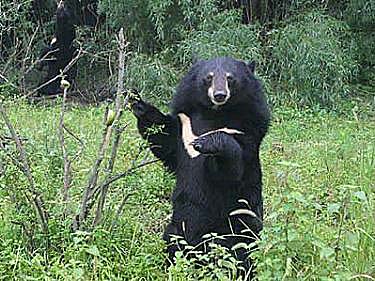Asiatic Black Bears are considered ‘vulnerable’ by the IUCN, and are suffering a rapid decline largely due to habitat loss, illegal trade in bile and paws, and conflict with humans. These bears are known to invade and consume farmers’ crops, especially that of corn, and can cause significant income loss in the process. This has resulted in a negative view of these animals and a lack of conservation in its range. Quality research and effective conservation efforts are needed to ensure their future.
Biologists and researchers concerned with the plight of these predatory mammals, and other wildlife living in Nepal, have come together to form a small, grassroots organization known as Bear Research and Conservation Nepal (BRCN). Established in 2008, the focus of BRCN is to research the way the bears utilize their habitat and their interactions with humans, in order to determine and implement the most effective actions needed to best protect this species and its ecosystem. Additionally, they are active in educating local communities about living with bears and try to inspire a conservationist attitude for both the bears and other wildlife.
The organization has diligently studied bears in and around protected national parks and reserves in Nepal. They collaborate with local, national, and international organizations to conserve, restore, and enhance habitat. BRCN understands the importance of a balanced ecosystem, and seeks to minimize negative impacts on it caused by humans. Aside from bears, the organization has also conducted research on the endangered Hispid Hare and threatened songbirds, such as the Hodgson’s Bushcat. This research will ultimately help them to identify and implement the most effective conservation strategies for protecting critical habitat.
 Hispid Hare (photo credit: Joanna Van Gruisen)
Hispid Hare (photo credit: Joanna Van Gruisen)
Many communities see these bears as threats to both their lives and their livelihoods. As a result of their fear and misunderstanding of these animals, the bears are often killed. The research BRCN conducts evaluates the bears’ habitat use, in order to identify areas where a clash with humans is likely. By identifying these areas, the organization can work with local communities to mitigate conflict with the animals.
Education and outreach are essential components to the conservation of wildlife, especially when human-wildlife conflict is part of the problem. Bear Research and Conservation Nepal works with government agencies to create education programs that target communities within the range of the Asiatic Bear. BRCN promotes a peaceful co-existence with these animals by teaching communities about the bear itself, and also what they can do to minimize conflict and crop raiding.
The organization has also been involved with a documentary about these predators. “Max’s Big Tracks- Nepal’s Yeti” was broadcast globally on the Animal Planet, and explored the history and folklore of the black bear in Nepal. BRCN hopes to continue developing documentaries and visual presentations in the future, in order bring needed attention to the status of this species. The organization is also planning to open a wildlife orphanage, which would be the first of its kind in Nepal. In collaboration with government and non-government agencies, this sort of orphanage would save lives and contribute to healthy wildlife populations.
For more information on Bear Research and Conservation Nepal, please visit their website.
![]()







